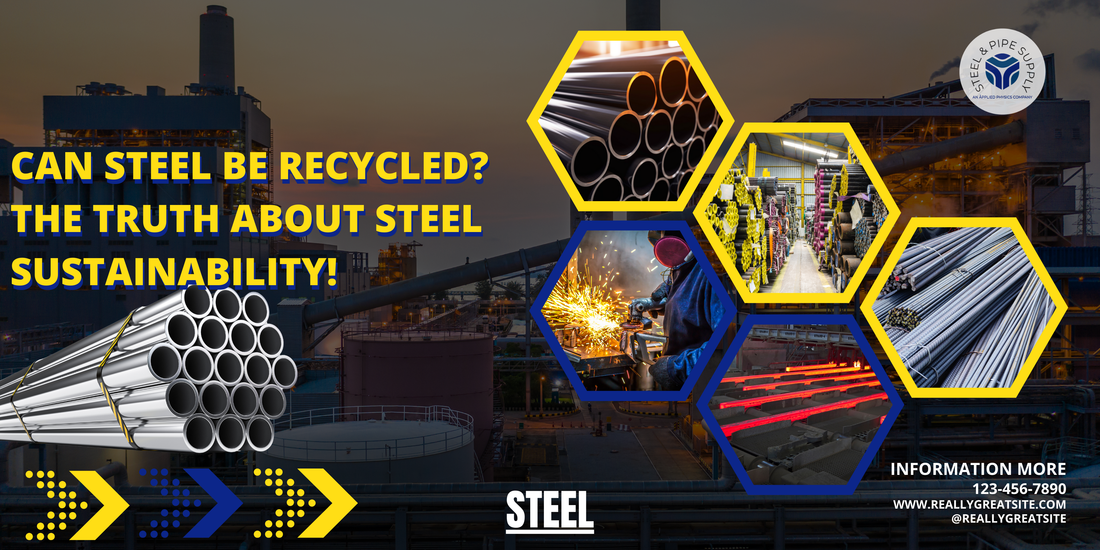
Can Steel Be Recycled? The Truth About Steel Sustainability!
Share
Introduction
Steel production has a significant impact on the environment, from the extraction of raw materials to the manufacturing process. The mining of iron ore and coal, which are the primary ingredients in steel production, can lead to deforestation, habitat destruction, and water pollution. Additionally, the smelting and refining of these raw materials release large amounts of greenhouse gases, such as carbon dioxide and methane, into the atmosphere.
These emissions contribute to climate change and air pollution, which can have detrimental effects on human health and the environment. Furthermore, the manufacturing process of steel involves the use of large amounts of energy, primarily from fossil fuels. This energy consumption not only contributes to greenhouse gas emissions but also depletes natural resources and exacerbates the effects of climate change.
In addition to the environmental impact of steel production, the disposal of steel products at the end of their life cycle can also pose a significant challenge. Steel is not biodegradable and can take hundreds of years to decompose in landfills, leading to the accumulation of waste and the release of harmful chemicals into the environment. Given these environmental concerns, it is crucial to explore sustainable solutions for steel production and consumption, including the recycling of steel.
Key Takeaways
- Steel can be recycled and is one of the most recycled materials in the world.
- The environmental impact of steel production is significant, but recycling steel can help reduce this impact.
- Recycling steel has numerous benefits, including conserving natural resources and reducing energy consumption.
- The process of recycling steel involves collecting, sorting, shredding, and melting down the steel to be reused.
- Steel recycling rates are high, and the economic and environmental benefits of steel recycling are substantial.
The Benefits of Recycling Steel
Recycling steel offers numerous environmental and economic benefits compared to traditional steel production. By recycling steel, we can reduce the demand for raw materials, such as iron ore and coal, and minimize the environmental impact of mining and extraction. This, in turn, helps to conserve natural resources, protect ecosystems, and reduce pollution.
Additionally, recycling steel requires significantly less energy compared to producing steel from raw materials. According to the Steel Recycling Institute, recycling steel can save up to 74% of the energy used in traditional steel production, leading to a reduction in greenhouse gas emissions and energy consumption. Moreover, recycling steel helps to divert waste from landfills and reduce the need for new landfill space.
This not only mitigates the environmental impact of waste disposal but also conserves valuable land and reduces the potential for soil and water contamination. From an economic standpoint, recycling steel can also create jobs and stimulate local economies. The recycling industry provides employment opportunities in collection, processing, and manufacturing, contributing to economic growth and sustainability.
Overall, the benefits of recycling steel are clear, making it a crucial component of sustainable resource management and environmental stewardship.
The Process of Recycling Steel
The process of recycling steel involves several stages, beginning with the collection and sorting of scrap steel. Scrap steel can be sourced from various places, including industrial sites, construction projects, and end-of-life products such as automobiles and appliances. Once collected, the scrap steel is sorted based on its composition and quality to ensure that it meets the specifications for recycling.
This may involve separating different types of steel, such as carbon steel and stainless steel, as well as removing any contaminants or non-metallic materials. After sorting, the scrap steel is processed through shredding and melting to prepare it for reuse. Shredding involves breaking down the scrap steel into smaller pieces using powerful machinery, while melting involves heating the shredded steel in a furnace to liquefy it.
During this process, impurities are removed, and alloying elements may be added to achieve the desired composition and properties. The molten steel is then cast into ingots or billets, which can be used as raw material for manufacturing new steel products. This closed-loop recycling process allows for the continuous reuse of steel without compromising its quality or performance.
Steel Recycling Rates and Trends
| Steel Recycling Metric | Data |
|---|---|
| Recycling Rate | Steel is the most recycled material in the world, with a recycling rate of over 88%. |
| Energy Savings | Recycling steel saves 56% of the energy needed to produce steel from raw materials. |
| CO2 Emissions | Recycling steel reduces CO2 emissions by 58% compared to producing steel from virgin materials. |
| Landfill Reduction | Recycling steel helps reduce the amount of steel waste sent to landfills, conserving valuable landfill space. |
Steel recycling has become increasingly prevalent in recent years, driven by growing awareness of environmental issues and the need for sustainable resource management. According to the World Steel Association, the global steel recycling rate reached 86% in 2019, demonstrating a significant increase from previous years. This high recycling rate reflects the industry's commitment to circular economy principles and its efforts to minimize waste and maximize resource efficiency.
Furthermore, advancements in technology and infrastructure have facilitated the expansion of steel recycling capabilities, making it easier and more cost-effective to recycle steel on a large scale. In addition to high recycling rates, there are several notable trends shaping the steel recycling industry. One such trend is the emphasis on closed-loop recycling systems, which prioritize the continuous reuse of steel without downgrading its quality or performance.
This approach minimizes the need for virgin materials and reduces energy consumption, making it a more sustainable option for steel production. Another trend is the increasing use of electric arc furnaces (EAFs) in steel recycling facilities, which offer greater flexibility and efficiency compared to traditional blast furnaces. EAFs can accommodate a wider range of scrap sources and produce steel with lower carbon emissions, making them a preferred choice for environmentally conscious manufacturers.
The Economic and Environmental Benefits of Steel Recycling
The economic and environmental benefits of steel recycling are substantial, contributing to sustainable development and resource conservation. From an economic perspective, recycling steel offers cost savings for manufacturers by reducing the need for virgin materials and lowering energy consumption. This can lead to improved profitability and competitiveness in the global market while creating employment opportunities in the recycling industry.
Additionally, steel recycling helps to stabilize commodity prices by mitigating fluctuations in supply and demand for raw materials. On an environmental level, steel recycling plays a crucial role in reducing greenhouse gas emissions, conserving natural resources, and minimizing pollution. By diverting scrap steel from landfills and incineration, we can mitigate the environmental impact of waste disposal and preserve valuable land and ecosystems.
Furthermore, the energy savings achieved through steel recycling contribute to climate change mitigation and resource efficiency. Overall, the economic and environmental benefits of steel recycling underscore its importance in promoting sustainable development and addressing global challenges related to resource depletion and environmental degradation.
Challenges and Limitations of Steel Recycling
While steel recycling offers numerous benefits, there are also challenges and limitations that must be addressed to maximize its potential. One such challenge is the collection and sorting of scrap steel, which can be complex and labor-intensive due to the diverse sources and compositions of scrap materials. Effective collection systems and advanced sorting technologies are essential for optimizing the quality and quantity of recycled steel while minimizing contamination and waste.
Another challenge is the presence of impurities and alloying elements in scrap steel, which can affect its recyclability and quality. Contaminants such as paint, coatings, or other metals may need to be removed or treated before the scrap steel can be recycled effectively. Additionally, alloying elements in certain types of steel may require specialized processing techniques to ensure that recycled steel meets industry standards and specifications.
Furthermore, transportation logistics and infrastructure play a critical role in facilitating efficient steel recycling operations. The availability of collection points, processing facilities, and transportation networks can impact the accessibility and cost-effectiveness of recycling services. Addressing these challenges requires collaboration among stakeholders across the supply chain, including manufacturers, recyclers, policymakers, and consumers.
The Role of Steel Recycling in Sustainable Development
Steel recycling plays a vital role in advancing sustainable development by promoting resource efficiency, reducing environmental impact, and fostering economic growth. As a key component of the circular economy, steel recycling contributes to closing material loops and minimizing waste generation throughout the product life cycle. By reusing scrap steel as raw material for new products, we can conserve natural resources, reduce energy consumption, and lower greenhouse gas emissions.
Moreover, steel recycling aligns with global sustainability goals related to climate action, responsible consumption and production, and sustainable cities and communities. By integrating recycled steel into manufacturing processes, industries can reduce their carbon footprint and enhance their environmental performance while meeting consumer demand for eco-friendly products. Additionally, steel recycling supports job creation and economic development in local communities by providing opportunities for entrepreneurship and innovation in the recycling sector.
Conclusion
Steel recycling offers a compelling solution for addressing environmental challenges associated with traditional steel production while unlocking economic opportunities for sustainable development. By embracing circular economy principles and investing in advanced recycling technologies, we can maximize the potential of steel recycling as a cornerstone of sustainable resource management. As we strive to build a more resilient and regenerative economy, it is essential to recognize the critical role that steel recycling plays in shaping a more sustainable future for generations to come.

